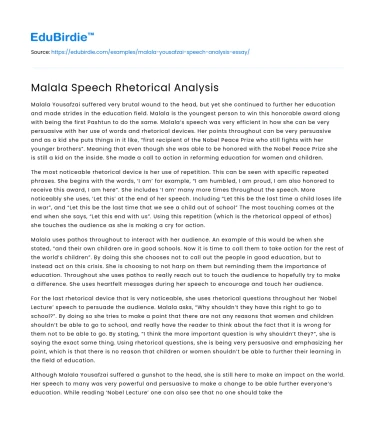Malala Yousafzai suffered very brutal wound to the head, but yet she continued to further her education and made strides in the education field. Malala is the youngest person to win this honorable award along with being the first Pashtun to do the same. Malala’s speech was very efficient in how she can be very persuasive with her use of words and rhetorical devices. Her points throughout can be very persuasive and as a kid she puts things in it like, “first recipient of the Nobel Peace Prize who still fights with her younger brothers”. Meaning that even though she was able to be honored with the Nobel Peace Prize she is still a kid on the inside. She made a call to action in reforming education for women and children.
The most noticeable rhetorical device is her use of repetition. This can be seen with specific repeated phrases. She begins with the words, ‘I am’ for example, “I am humbled, I am proud, I am also honored to receive this award, I am here”. She includes ‘I am’ many more times throughout the speech. More noticeably she uses, ‘Let this’ at the end of her speech. Including “Let this be the last time a child loses life in war”, and “Let this be the last time that we see a child out of school” The most touching comes at the end when she says, “Let this end with us”. Using this repetition (which is the rhetorical appeal of ethos) she touches the audience as she is making a cry for action.
Save your time!
We can take care of your essay
- Proper editing and formatting
- Free revision, title page, and bibliography
- Flexible prices and money-back guarantee
Malala uses pathos throughout to interact with her audience. An example of this would be when she stated, “and their own children are in good schools. Now it is time to call them to take action for the rest of the world’s children”. By doing this she chooses not to call out the people in good education, but to instead act on this crisis. She is choosing to not harp on them but reminding them the importance of education. Throughout she uses pathos to really reach out to touch the audience to hopefully try to make a difference. She uses heartfelt messages during her speech to encourage and touch her audience.
For the last rhetorical device that is very noticeable, she uses rhetorical questions throughout her ‘Nobel Lecture’ speech to persuade the audience. Malala asks, “Why shouldn’t they have this right to go to school?”. By doing so she tries to make a point that there are not any reasons that women and children shouldn’t be able to go to school, and really have the reader to think about the fact that it is wrong for them not to be able to go. By stating, “I think the more important question is why shouldn’t they?”, she is saying the exact same thing. Using rhetorical questions, she is being very persuasive and emphasizing her point, which is that there is no reason that children or women shouldn’t be able to further their learning in the field of education.
Although Malala Yousafzai suffered a gunshot to the head, she is still here to make an impact on the world. Her speech to many was very powerful and persuasive to make a change to be able further everyone’s education. While reading ‘Nobel Lecture’ one can also see that no one should take their education for granted since some aren’t as blessed as us to get the education that we all do.






 Stuck on your essay?
Stuck on your essay?

